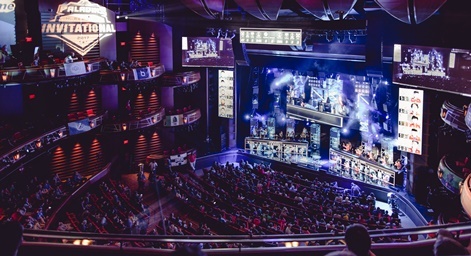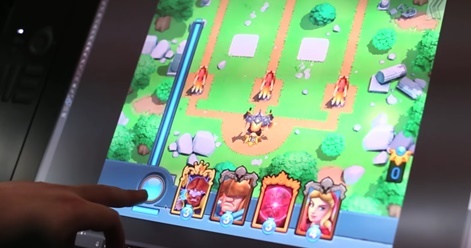The Hi-Rez Expo in Atlanta, Georgia earlier in January 2016 hosted the SMITE World Championships along with the PaladinsInvitational.
But Hi-Rez also had their upcoming mobile game SMITE Rivals on display at the event too.
It’s a mobile card arena, with many folks drawing close comparisons between Rivals and Supercell’s smash-hit Clash Royale.
SMITE Rivals features familiar faces from SMITE’s mythological pantheon, along with a number of other collectible cards players can use on the three-lane game board to take out their opponents in battle.
We sat down with SMITE Rivals’ Lead Designer Brian Grayson during our stay at Hi-Rez expo to talk mobile game development, eSports and community-building.
PocketGamer.biz: So how do you make that jump from making console or PC games to mobile titles?
Brian Grayson: You just decide, like anything. You just gotta jump into it. You look at the market and you learn from the market, and you learn from your own trial and error, and you go after it.
Jetpack Fighter [Hi-Rez’s first mobile game] helped pave the way a lot for SMITE Rivals. There were so many valuable lessons there.
The way gamers interact on every different platform is surprisingly different. So people on PC, maybe they're really tuned into Facebook. Then you go to mobile and they're tuned into Twitter, actually, because you have the frictionless ability to click and find [games] in the App Store.
We just kind of jumped into it and it's been fun ever since.
Were there any unique challenges for developing for mobile?
Grayson: The way we develop games is we create what we think is the minimum viable game that can be shared with the public and then it continues to be built upon toward a full release.
And in PC that ends up being a closed alpha, a closed beta, an open beta, and then a release. On mobile, that does not happen. The tools are very different and what players have learned in terms of expectations from developers is different.
So on mobile, the common practice is, as you know, to soft launch and then a release. So it's been interesting trying to figure out what our strategy's going to be for a game like SMITE Rivals where it's not just a mobile game, it's a PC game as well, and you're able to play it on both.
So our release cycle is going to be a little different and the way we're going to test it with our community is going to be a little different.
More people will inevitably have access to it in an early access form on PC. And then mobile will follow what the market does and do a soft launch, and then we'll pretty quickly try to get to a global release so that everybody can experience the magic.
And it'll be cross-platform? So mobile players can play against people on PC?
Grayson: Exactly, and it's not just playing it. I mean, we really want it to be one and the same ecosystem. If you're on PC and I'm on my phone, we can certainly play against each other.
We don't want you to have to try and invest time in two different spots because you enjoy playing on two platforms.Brian Grayson
But similarly, when I'm on my phone, if I decide to spend most of my time on my phone or even if I make a purchase on my phone, if I go to my PC, all of that's going to carry over.
So we don't want to divide players. We don't want you to have to try and invest time in two different spots because you enjoy playing on two platforms. We want it to be convenient for you.
What went into keeping Rivals tied to SMITE while also developing a new experience for your fans?
Grayson: [Rivals] started out in a landscape version where there was a scrolling screen and everything. What we found when we tested it internally was people didn't think it felt as much like SMITE.
It was the SMITE characters, for sure, but it didn't have all of the elements for what people have learned SMITE is.
As you're building up that world, you can't just immediately jump away from all of those expectations. You have to slowly grow the world.

So we said okay, what are the fundamental things we think people are really gonna want? Three lanes. Instead of one lane we added three lanes.
So you're going to want your base, you're going to want your phoenixes, and your titans, so we added that. And you're definitely going to want gods. Gods are like the cornerstone of SMITE, right?
Mythology is what's so compelling about it and falling in love with these great characters like Neith and Thor. So we knew that gods had to be a fundamental piece of that. And we just kind of played with a bunch of different designs and eventually it ended up with what we got for SMITE Rivals.
To be honest, I was super nervous about people trying it and wondering whether or not they would be happy with that given that it's not a MOBA. And we also reimagined how SMITE characters look.
I was super nervous about people trying it and wondering whether or not they would be happy with that given that it's not a MOBA.Brian Grayson
We made them more cute and cuddly as opposed to keeping the epic, very detailed feel which won't read as well on mobile with the isometric camera angle that we went with. Fortunately, people are digging it, so it's really cool.
How did you envision the gods adding another layer of strategy to the game? I feel like that's something I haven't seen in other collectible card arenas.
Grayson: We knew for sure that, like I said, it's SMITE. When you play it, your focus is a god, so we needed to preserve that.
We could take the titan out and we could make the titan a god. But then the god is kind of like a glorified building. They're not moving around. It's not as cool. So we said, no, the god definitely has to enter the battlefield and own people.
So we said okay, let's add a god power and let's add a passive so that way the god can really be the cornerstone of your deck and everything you add will be based on what god you've chosen.
And we'll only let you bring one god, not multiple gods, and we'll make you bring one god, just like you can't play SMITE without picking your god - it wouldn't let you. And that was the magic formula for us. It worked really well.
So you have these gods that have cool powers that always cost you mana, but give you roughly four mana of value. You have these passives that encourage you to pick particular cards out of a wider pool of cards to supplement that god, and then you still have the awesome god owning people.
Do you have plans to push SMITE Rivals as an eSport?
Grayson: Hi-Rez's policy is to let the community decide the direction they want to take the game. If the community in Rivals really wants it to be a competitive game, we will absolutely get behind that. And I think they will.
On the show floor yesterday, I witnessed the very first Rivals tournament. A few fans got together and decided they would play against each other in tournament format and they did it. I think it was like a four person double elimination tournament. They just played and it was awesome. So I think the demand is there.

I think the gameplay totally caters to it. And we know eSports really, really well. I wouldn't be surprised if we go that direction and we get behind it.
Mobile eSports is particularly fascinating, too, because it's still an emerging area. It's still really new, it's just budding. Everybody knows that they want it.
There's already been some competitions that had a really big viewership. It's just, people are trying to figure out how it's going to work. We would really love to be a part of that. If the community tells us, hey, we want to play this competitively, then we'll be there to support them.
Did your background in eSports inform your development process at all?
Grayson: I think it did, actually. I am very sensitive to online multiplayer games and preserving fair gameplay inside of those games.
Fun is the important piece, because if you're not having fun, I don't think we're doing what we should be. Even if you lose, it's close competition. It's fun.
That is great game design if you can lose every game for seven hours and still have fun.Brian Grayson
I remember playing another game like this in a custom mod community for seven hours straight with a friend of mine. We lost every game for seven hours. And at the end of it, we were both smiling.
That is great game design if you can lose every game for seven hours and still have fun.
So for us, looking at that and thinking about the competitive side of things where people are going to get really into the numbers and the specific value of like, "How am I gaining value by playing a card with this mana?"
That has influenced a lot of the design. It was super important that you could play the game - we actually ran a lot of tests on this by the way - without knowing anything about the game and complete a match, and it was good.
But the people who want to really get into it and strategise and form our meta have the depth in every single card to be able to do that. I am hopeful that we attained our goal, but time will tell.
You were telling me how people were already having tournaments at the show. What role does the community play when making this game? How are you hoping to build a community around Rivals once it's live?
Grayson: The community's going to play a huge role in development. When we move forward, we really want to hear from the community what gods they want to see, what characters they want to see and what kind of game mechanics they want to see.

Then we're going to go to the drawing board and figure out how can we add this to the game and preserve the awesome formula that caused all of you to come play this game and choose to spend your time with us to begin with
So there's no world where this game continues without the community. There's no world where they don't have a big hand in it. I'm on Twitter all of the time. I'm reading tweets.
I'm reading feedback. I'm on Reddit. And I'm paying attention to what people want and the rest of the development team is as well. So they'll have a huge hand in helping us form it.
In terms of us helping the community form, I think listening is a big piece, but also giving that incentive to share things with each other and interact.
I want us to be able to cultivate a community where you can meet people in the game or in the community and really make lifelong friendships. We're very focused on how we can attain that and how we can support that
We've got a few ideas that I can't share quite yet for stuff in the game, but outside of the game and in the community it means being active and starting dialogues with people on Reddit, on websites, on forums and on social media; not just hiding but really engaging.




















